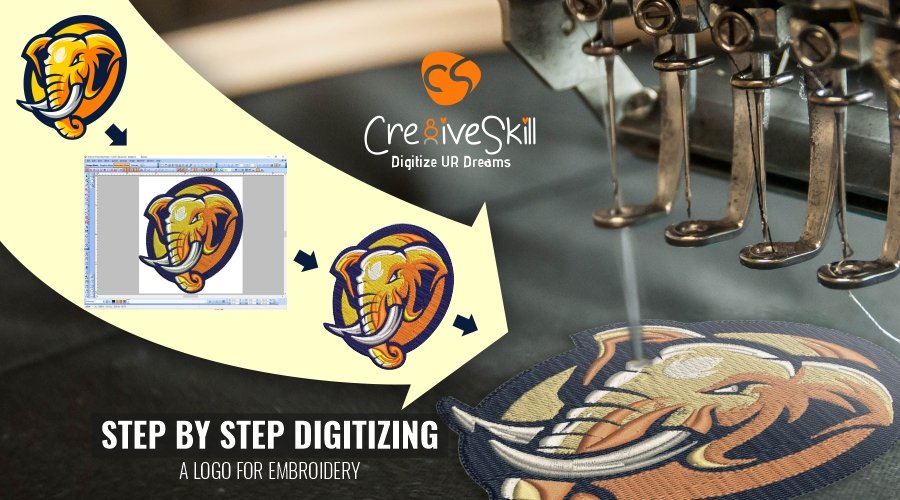Top-Rated Digitizing for Embroidery: Perfect Stitch Every Time
Top-Rated Digitizing for Embroidery: Perfect Stitch Every Time
Blog Article
Understanding the Embroidery Digitizing Process: Your Ultimate Overview
Embroidery digitizing is a precise craft that needs accuracy and know-how to convert intricate designs into digital styles for equipment embroidery. As artisans embark on this journey to grasp the needlework digitizing procedure, a detailed understanding of the basics establishes the foundation for quality.

Recognizing Needlework Digitizing Essentials
Embroidery digitizing basics form the structure upon which detailed layouts are converted into machine-readable formats for accurate sewing. This preliminary action in the embroidery digitizing procedure is important for guaranteeing that the final embroidered product is a faithful depiction of the initial design. Recognizing embroidery digitizing fundamentals involves comprehending key ideas such as stitch kinds, stitch direction, density, rug, and pull compensation.
Sew types play an important role in determining the aesthetic and textural end result of the stitched style. By choosing the ideal stitch kind, whether it be satin, fill, or running stitch, digitizers can attain the wanted result and improve the total high quality of the needlework. Furthermore, sew instructions affects the flow and dimension of the style, while density figures out the spacing and insurance coverage of the stitches.
Furthermore, padding sewing provides security to the layout by safeguarding the fabric and avoiding distortion during the embroidery process. Draw settlement is an additional essential consideration to neutralize the natural propensity of material to contract when sewn. Mastering these needlework digitizing fundamentals is essential for producing professional-quality embroidered items.
Selecting the Right Digitizing Software Program
Picking the suitable digitizing software program is a crucial choice that considerably influences the efficiency and high quality of the embroidery digitizing process. Digitizing for Embroidery. When selecting the ideal digitizing software program, it is necessary to take into consideration factors such as the complexity of styles you prepare to develop, the user-friendliness of the software program, the level of consumer support used, and the compatibility with your needlework maker
There are numerous digitizing software program options available out there, varying from standard programs for newbies to innovative software for expert digitizers. Some preferred choices include Wilcom EmbroideryStudio, Hatch Embroidery Software Application, and PulseID. These software offer a broad variety of devices and attributes to help you create detailed designs effortlessly.
Before making a decision, it is recommended to discover the various software program alternatives via cost-free tests or demonstrations to figure out which one finest fits your needs. Additionally, reading testimonials and looking for referrals from seasoned digitizers can supply useful insights right into the toughness and weak points of each software (Digitizing for Embroidery). By thoroughly evaluating your demands and comparing the attributes of different digitizing software program, you can make an enlightened option that boosts your needlework digitizing operations
Digitizing Tools and Techniques

Optimizing Layout Setup for Needlework
Understanding the complexities of style settings is fundamental in achieving optimal lead to the embroidery digitizing procedure, structure upon the structure laid by comprehending digitizing tools and methods. When enhancing style setups for needlework, it is vital to take into consideration aspects such as stitch kind, thickness, padding, draw settlement, and enrollment. Sew kind selection influences the total feel and look of the layout, with options like satin, fill, and running stitches supplying various structures and results. Thickness describes the spacing and thickness of stitches, affecting the design's insurance coverage and durability. Proper rug sewing gives security and stops material distortion, especially for intricate styles or on stretchy products. Pull settlement changes for textile stretch during stitching, ensuring precise design replication. Enrollment settings straighten different elements of the style accurately, keeping general layout stability. By fine-tuning these layout setups, embroiderers can boost the high quality and accuracy useful reference of their embroidered productions.

Troubleshooting Common Digitizing Issues
When experiencing usual digitizing issues throughout the embroidery process, it is vital to comprehend the origin causes and carry out efficient services without delay. One typical issue is stitch thickness concerns, where stitches may be right here as well thick, causing the material to tighten, or also sparse, causing voids in the design. Changing the stitch thickness setups in the digitizing software program can help fix this problem.
Another regular obstacle is string breaks throughout the embroidery process. This can happen because of numerous factors such as wrong tension settings, dull needles, or utilizing low-grade string. Making certain correct maintenance of the needlework device, including routine needle modifications and stress modifications, can decrease the event of string breaks.
Moreover, design registration errors can result in misaligned elements within the needlework design. Checking the design alignment in the digitizing software application and making needed modifications prior to stitching can assist in avoiding this issue. By dealing with these common digitizing issues promptly and effectively, you can ensure a smoother needlework procedure and high-grade ended up items.
Final Thought
To conclude, understanding the embroidery digitizing procedure calls for a strong understanding of the fundamentals, the right choice of software program, and understanding of tools and techniques. Maximizing layout settings and troubleshooting usual digitizing issues are vital action in ensuring high-quality needlework results. By following these actions carefully, one can achieve accuracy and effectiveness in the digitizing process.
Report this page